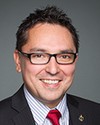Yes, thank you, Mr. Chair.
I'd like to first of all acknowledge the Creator, the creation, the prayers, and the protocols. I also want to acknowledge the traditional territory of the Algonquin people.
I want to acknowledge Cindy Blackstock, the previous presenter, and thank her for all the work she's been undertaking with the Canadian Human Rights Tribunal on child welfare.
As well, I want to note that I have Ken Young sitting beside me, as a reminder and recognition of the era of reconciliation. Ken is a Indian residential school survivor. He's a leader in our first nations communities and somebody who well knows these issues. I have him beside me to help keep me focused on the fact that much of what we're doing is about the modern era of reconciliation and the important work that needs to be done through these committee presentations.
I also want to acknowledge the first nations leadership that is here, and the committee members.
I am presenting as the Ontario regional chief, and as a member of the AFN executive who holds the portfolio for health, and the chair of the Chiefs Committee on Health at the AFN.
I am also presenting as a proud member of the Serpent River First Nation, and as such, these are not just policy discussions for me, but literally life and death discussions and decisions that must be made here in Ottawa and that will profoundly impact the families in communities like mine.
We must always be on guard for the issue of suicide. As we've seen in recent days, the community of Woodstock in southern Ontario has fallen victim to a trend of suicide that's putting the question of suicide in front of all Canadians.
Before I proceed with my remarks, let me point out that the current suicide crisis will only end if we have addressed all the social determinants of health.
Our communities need clean water, safe and adequate housing, a decent education system, and economically sustainable communities. Once we move from the third world conditions in our communities to those of mainstream Canada, and once our children are no longer living in desperate situations, then this national crisis will end. Simply put, the people sitting around this table can finally recommend that we end Canada's greatest shames: first nation poverty and despair, and its manifestation in suicide.
When it comes to the roots of the crisis, as you have heard throughout your study, suicide in first nations communities is the result of the coming together of many historical, social, political, economic, and environmental factors that collectively make up the social determinants of health. I want to underscore one thing. I don't want to get into it in-depth, but I must also underscore the serious nature of climate change and what that must be doing to the minds of individuals, and the collective identity and feelings that people must have in the remote north. I believe that some of the suicidal ideation can be and probably is connected to the issue of climate change.
The most profound of these factors is settler colonialism. Colonialism displaced first nations people from our lands and waters, and thus our sources of identity, spirituality, and economic security. First nations governance systems were undermined and replaced by foreign systems based on profoundly different world views grounded in hierarchy and patriarchy. Our languages were literally beaten out of the children at the residential schools. Children were stolen from their homes to face physical, sexual, and psychological abuse in these schools.
The staggering rates of first nation children in the child welfare system demonstrate that this painful legacy continues, as eloquently outlined in great detail by Cindy Blackstock in the previous presentation.
First nations youth face the daily stress of having to face a Canadian society that claims to be built on the principles of fairness, justice, and respect for diversity, while they survive in communities without basic necessities like schools and clean water. At the same time, the comments sections of new stories about them are filled with comments that they are living the high life on the taxpayers' dime.
With all of this in mind, the suicide crisis facing our youth should come as no surprise. In fact, it is an entirely expected outcome given what our youth and our communities face every single day.
I must point out that the demographic profile of those who attempt or commit suicide is vastly changing. Children and elders in their twilight years committing suicide is not the norm, but that is becoming increasingly evident in the statistics on suicide in first nations. The suicide of a 10-year-old boy in the Nishnawbe Aski Nation territory and an elder in the Treaty 3 region are just two examples that I would cite where the culminating issues had to do with the lack of primary health and mental health services—point blank, as a result of funding cuts to health services in first nations over the last decade.
The question then becomes: what can be done?
I will move forward to address suicide. It is imperative to address the social determinants of health in first nations and to support and advocate for community-based approaches to suicide prevention, which our youth refer to as “life promotion”, which simply means investing and paying it forward in developing programs for youth and their communities. Youth need the decision-makers to prioritize them and to generate hope among them through strategic investment.
We commend Minister Philpott for meeting with our youth just yesterday. I want to quote something that the minister said, as it pertains to the meeting:
I am grateful for this opportunity to speak directly with First Nations youth, and I want to thank the AFN National Youth Council members for bringing their concerns and ideas to the table. Their willingness to talk about their challenges, and how we can work together to address them, helps me better understand how the Government of Canada can support their well-being. Their support is a critical factor in generating positive, long-term change.
I must commend the youth, the AFN, and the minister for their efforts and the important work that will come from the round table.
At the same time I want to see three things resulting from Minister Philpott's words. The first is that we need action now—defined, budgeted, and collaborative efforts. The second thing is that we need the minister to ensure that medium- and long-term planning in health accord negotiations must formally include our youth as part of that process. Thirdly, we need the minister to work with the youth of the AFN to formalize life promotion as more than just ideology. We need to build strategic investments that work towards the diminishment of suicide through programs aimed at moving from the current national suicide crisis in our youth populations to a greater focus of strengthening a new generation of young people who are empowered to want life over death. Of course, their lives must be seen as worthy, worth living, and worth the effort of strategic investments by this government.
We need the full implementation of the first nations mental wellness continuum framework and the added element of youth in life-promotion strategies. The framework outlines opportunities to build on community strengths and control of resources in order to improve existing mental wellness programs for first nation communities. This includes community development, as indicated by the previous speaker; quality care systems and competent service delivery; collaboration with partners; enhanced flexible funding; and ensuring that culture is at the centre of the mental wellness continuum framework.
Full implementation means increasing the amount of flexibility of resources to increase capacity, and to ensure quality care systems and competent care delivery so that all first nations have access to the essential basket of services that make up the continuum of care.
On the social determinants of health, as mentioned previously, health outcomes cannot be addressed by health care system interventions alone. What is required is a real and substantial investment in the social determinants of health, including adequate and safe infrastructure, culturally relevant education, a reformed child welfare system, and economic opportunities, among other things.
In addition, research demonstrates that self-determination and cultural continuity act as an important hedge against youth suicide; therefore, community self-determination and support for cultural activities are also life-promotion activities that are needed.
With the commitment to nation-to-nation dealings, and the investments in budget 2016, the new government has made an important step in addressing the social determinants of health, but the reality is that first nation youth continue to sit in mouldy, over-crowded houses without clean water. Much work needs to be done. They have waited long enough.




